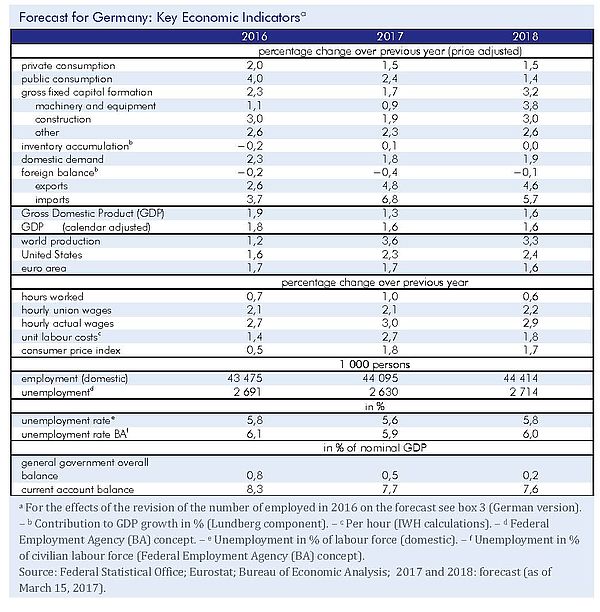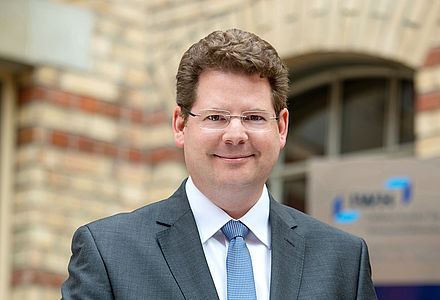The German Economy: Employment Boom in Germany, but no Overheating of the Economy

The global economy
At the beginning of 2017, the global economy appears rather strong. Business sentiment has risen in many places, and both industrial production and world trade increased at the end of last year. In the U.S. as well as in the euro area, domestic demand further strengthened at the end of 2016.
This is quite remarkable, considering the extensive uncertainties surrounding economic policy. In particular, it is uncertain how much of the protectionist views of the new U.S administration will find their way into actual politics
The price of crude oil is currently (midmonth March) about 40% higher than it was in March 2016. This base effect is passed on to the rates of increase of consumer price indices all over the world. There is, however, hardly any sign of a strong increase in inflationary dynamics besides this effect, although inflation expectations in financial markets have been revised upwards somewhat in the past months. This also corresponds to a rather optimistic view dominating at financial markets regarding the effects of the future U.S. economic policy. All in all, economic policy currently bolsters the economies in many places. If no serious shocks hit the global economy, the robust expansion should continue over the course of the year. “This is quite remarkable, considering the extensive uncertainties surrounding economic policy. In particular, it is uncertain how much of the protectionist views of the new U.S administration will find their way into actual politics,” Holtemoeller says.
The German economy
At the end of 2016, the German economy, mainly supported by domestic demand, expanded at about the same rate as potential GDP. The expansion is based on strong employment growth and real incomes per capita that have been rising for the last three years now. The contribution of exports to the expansion of GDP, however, was outdone by strongly growing imports.
At the beginning of 2017, the business outlook improved further in the private industry, although less favourable weather conditions probably dampened gross value added of the construction sector and its suppliers. In sum, overall production is expected to expand by 0.4% in the first quarter.
Domestic demand will continue to be the main source of expansion in the later periods of the forecast. Construction in particular will return to a strong growth path, since the volume of new orders is high, as costs of refinancing are still very low and local authorities have ample means to spend. Capacity utilisation is above average by now, and since the expansion will go on and refinancing costs stay low, investment of firms in both construction and equipment will increase a bit faster. Private household spending will continue at the current pace, although the rise in prices of energy and food has a dampening effect on private consumption, because the labour market is in an exceptionally strong state. Overall, domestic demand will remain strong, advancing at a rate of 1.9%. Exports will, in accordance with expected global demand, slightly decelerate over the course of the years 2017 and 2018.
In 2017, GDP will increase by 1.3% and thus at a lower rate than in the previous year, but this is only due to fewer working days and not to sliding demand
Based on this forecast, GDP is expected to increase by 1.3% in 2017 and by 1.6% in 2018. This difference is mainly due to the different numbers of working days, and not due to a cyclical downswing. Capacity utilisation in Germany is expected to be about normal over the forecast horizon.
In 2016, the unemployment rate dropped below the level of 6% for the first time since the German reunification. However, in the course of the year 2017, the unemployment rate will gradually increase, as the number of refugees registered as unemployed will rise noticeably. Still, on average the unemployment rate will be only 5.6% in 2017.
The East German economy in 2017 will expand about as strongly as in Germany as a whole, and unemployment declines further: This forecast has an unemployment rate of 7.7% for East Germany on average in 2017.
Whom to contact
For Researchers

Vice President Department Head
If you have any further questions please contact me.
+49 345 7753-800 Request per E-MailFor Journalists

Head of Public Relations
If you have any further questions please contact me.
+49 345 7753-720 Request per E-MailIWH list of experts
The IWH list of experts provides an overview of IWH research topics and the researchers and scientists in these areas. The relevant experts for the topics listed there can be reached for questions as usual through the IWH Press Office.



